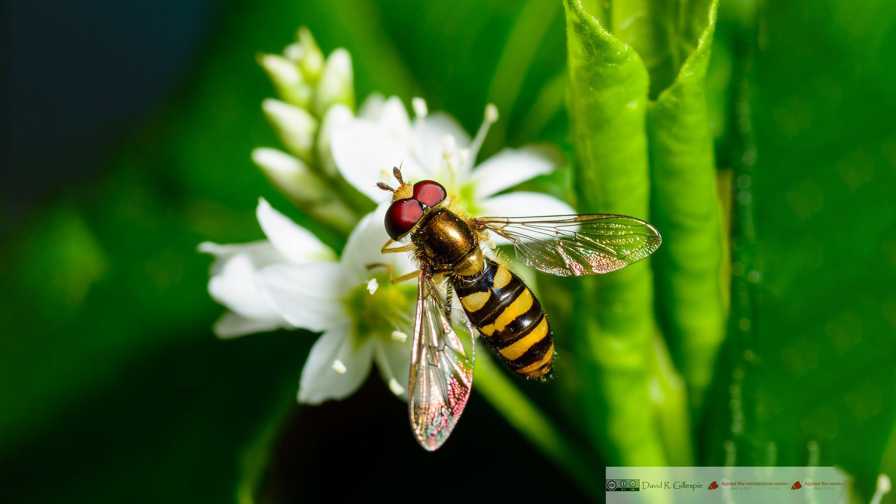Plant Researchers on the Hunt for New Biocontrol Agents

The hoverfly (Eupeodes americanus) is being considered by researchers as one of several apt biocontrol agents for pests like aphids.
Photo by David R. Gillespie and Applied Bio-nomics
Biological control for greenhouse integrated pest management (IPM) is booming. Some biocontrol agents, such as the whitefly parasitoid Encarsia formosa and the spider mite predator Phytoseiulus persimilis, have been commercially sold as pest control since the 1960s. Although certain biocontrol species are used all over the world, others are not available because of regulations preventing the importation of non-native species. In addition, several pests do not yet have effective biocontrol solutions. Therefore, opportunities exist to develop native biocontrol agents.
However, not every bug that eats a pest is necessarily a good biocontrol agent. Three researchers, Marc Fournier at the Université de Québec à Montréal and Taro Saito and Nadine Gaskell at Vineland Research and Innovation Centre, discuss the predators they are working on to understand their potential for biocontrol in greenhouse crops in the near future.
Where and how did you find your study organism?
Marc Fournier: We are working on a predatory hoverfly (the long-tailed aphideater, Eupeodes americanus). This fly naturally enters greenhouses in Quebec to lay eggs near aphid colonies. The larva feeds on aphids. We collected adult hoverflies on flowering plants (Phlox sp.) in my garden and close to strawberry fields in the province of Quebec.
Nadine Gaskell: My two main approaches were to think like a pest and then like a generalist predator. Because I was looking for specific generalist predator families (Nabidae, Miridae), I did a literature search to identify host plants and landscapes where they might be found. I surveyed outdoor crops that are attractive to pests and field edges, train tracks, and ditches with wild vegetation. I also visited local community gardens that do not use pesticides, as this encourages a rich biodiversity.
Taro Saito: While showing my one-year-old son the wonderful nature in our backyard, he spotted something — it was an anystid predatory mite. When it caught a small fly in front of my eyes, I ran inside to get an aspirator and collected a dozen or so specimens.
How did you know you found a potential biocontrol agent?
Fournier: By investigating its biology [predatory hoverfly], we found that it feeds on several species of aphids like green peach aphids, pea aphids, and melon aphids.
Gaskell: We are still in the early stages of predator discovery. Every time I collected an individual that fits certain criteria with regards to the host plant, body shape/size, mouth parts typical of predators, etc., I exposed it to common greenhouse pests, such as aphids, thrips, whiteflies, and spider mites to determine if it would prey on them.
Saito: In the laboratory, the mites consumed all the pest species I gave them, especially thrips. I knew I found something special when one of the mites caught adult thrips within a few seconds after their release in the dish. A literature search showed that it is an effective generalist and the importance of naturally occurring populations of these mites for pest control in, for example, apple orchards.
What is the most interesting characteristic of your study organism?
Fournier: The hover fly larva is a furtive predator, meaning it can feed in an aphid colony without disturbing the aphids. It can clean up an entire plant. The adults can live one month and lay more than 700 eggs. It is also very efficient at low temperatures, making it an ideal predator against foxglove aphids in spring crops.
Gaskell: Everything! It is a nabid (damsel bug) predator, and it has not been investigated much. This makes every bit of collected information exciting, as I draw similarities and/or differences from closely related species. It is interesting to see it move and interact with its surroundings. As a wingless species, it frequently hops to attack prey, to escape attack, and to move around plants. It also appears to have a very curious nature, as it will extend its front legs to touch various surfaces.
Saito: The mites reproduce without males (parthenogenesis). There are only female specimens known for this species.
What are the next steps to get your new biocontrol agent to market?
Fournier: We are working with a commercial insectary, Applied Bio-nomics, on a mass-rearing method. We expect the hoverfly will be available soon.
Gaskell: We will conduct larger-scale experiments to compare several new biocontrol agents to currently available ones within a greenhouse setting. This will allow us to determine which species to pursue, based on how well they fare against commercially available agents.
Saito: This mite species was once considered for biocontrol in the 1960s but regarded as unsuitable for mass production. Yet, we are currently fine-tuning mass-rearing methods to produce these predators at a reasonable cost. The final step will be for biocontrol companies to scale up the rearing methodologies to fit within their production process. Alternatively, growers may rear their own mites for a constant supply of predators in their crop. I believe this predatory mite will make biocontrol programs more robust, because it attacks both common pests and occasional or difficult pests, reducing the chance of ruining a biocontrol program with the use of an emergency chemical spray.
This research is supported by the AgriScience Program under the Canadian Agricultural Partnership of Agriculture and AgriFood Canada.









